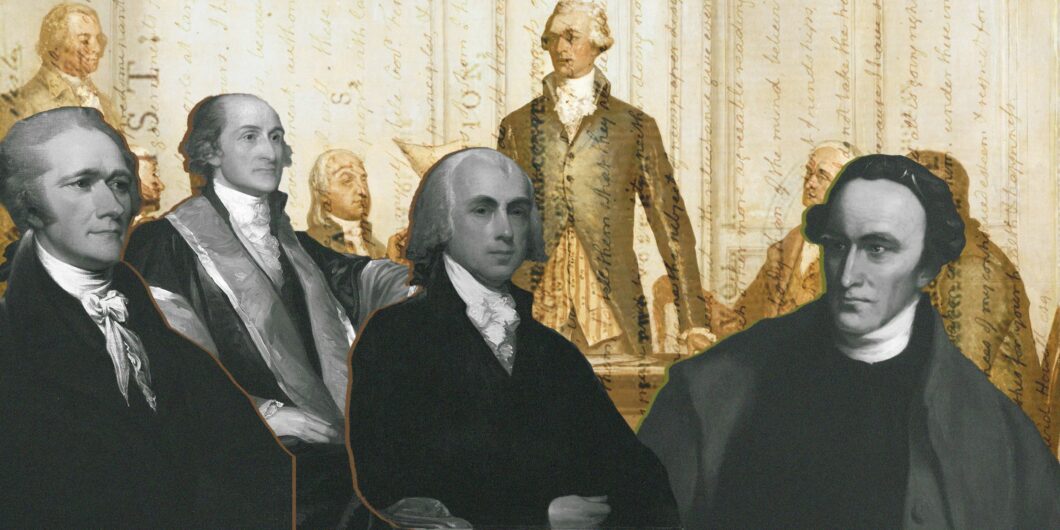The Federalist Reconsidered
The Federalist—a 180,000-word exegesis of the 4,400-word supreme law of the United States—will be read as long as anything resembling the American republic endures. It will be studied not only for its insights into the eighteenth century, but also for its understanding of the unending conundrum of how to align public regulation with the infinite peculiarities of human nature.
Reconsidering the essays, one is struck by the sheer improbability of the accomplishment. As Bernard Bailyn pointed out, these writings, although often assumed to be the work of disinterested political theorists, were actually “polemical essays directed to specific institutional proposals written in the heat of fierce political battle which every informed person knew would determine the fate of the new nation.” And the Federalist was not the product of mature consideration; at one point, two essays appeared weekly in New York newspapers.
It was the work of three authors—Alexander Hamilton, James Madison, and John Jay—who consulted little if at all with one another, a fact that lent an incongruity to some of their arguments. John Quincy Adams, after reading essays 9 and 10—written by Hamilton and Madison, respectively—thought the differences in style and content so profound as to amount to “rival dissertations.” Thus, one is puzzled by Martin Diamond and Willmoore Kendall’s assertion that a monolithic “Publius” ever existed. As Lance Banning observed, the Federalist displays “the enduring marks of a collaborative effort by men whose clashing views, within a few years’ time, would be responsible in no small part for the emergence of the warring political parties that ‘Publius’ had feared.”
The sources of these differences are not terribly difficult to discover. For one, Madison, who was present throughout the Constitutional Convention, had a better understanding of the debates and proceedings than Hamilton, who left the convention in late June and did not return until early September, missing more than a third of the sessions. Yet more to the point, the essays displayed the two authors’ very different—if not antithetical—temperaments and beliefs that would, within five years, put them on opposite sides of one of the most brutal political contests in our nation’s history.
For all the encomiums Federalist no. 10 has received through the years, scholars have seldom asked one simple question: Did it work?
Take, for example, Madison and Hamilton’s respective discussions of national defense in the proposed and newly empowered federal government. In no. 45, Madison carefully attempted to allay Anti-federalist fears of an overpowerful federal government: “The powers relating to war and peace, armies and fleets, treaties and finance, with the other more considerable powers, are all vested in the existing Congress by the articles of Confederation. The proposed change does not enlarge these powers; it only substitutes a more effectual mode of administering them.” Hamilton, on the other hand, cared little about such traditional republican misgivings. In Federalist no. 23, he proclaimed that the ability “to raise armies—to build and equip fleets—to prescribe rules for the government of both … ought to exist without limitation.” As if any ambiguity lingered, he further declared that “the circumstances that endanger the safety of nations are infinite; and for this reason no constitutional shackles can wisely be imposed on the power to which the care of it is committed. … The means ought to be proportioned to the end.” Here, in embryo, is the irritant that would shortly create the Federalist and Jeffersonian Republican parties: Hamilton’s ardent desire to create a fiscal-military regime that would allow the nascent United States to compete on the world stage with Britain and France.
Yet, for all the circumstances that attended their creation—the haste, the disputation, the foreshadowing of future conflict—to reread the Federalist is to appreciate the remarkable insights that abound throughout the less well-known of the eighty-five essays. Madison’s no. 37, for example, subtly argues how the proposed Constitution would strike a balance between the ancient antinomies of power and liberty. And Hamilton, in Federalist no. 15, gave poignant expression to his and countless other Americans’ fears that the “imbecilities of our government” under the Articles of Confederation had led to “national humiliation” at the hands of the foreign belligerents.
Nonetheless, the reader is also reminded why certain essays—the greatest hits, so to speak—have garnered more attention than others. In particular, nos. 10 and 51, both the handiwork of Madison, stand apart in their acuity and their insights, yet for very different reasons. There is a twoness to both papers. On the one hand, they shed light on the transient—the eighteenth-century moment in which they were composed. On the other hand, the essays speak to continuing issues of governance and the human condition. Thus, the Federalist, like any other document of value, is at once timeless and, for lack of a better word, “timeful.” To make such a distinction, however, by no means is to suggest the latter is inferior to the former, at least for the historian. Timefulness, after all, is our stock-in-trade.
Number 10 is a beautifully constructed essay—an exercise in theoretical reasoning that, according to Edmund Morgan, was “the most fruitful intellectual achievement of the Revolution period.” The essay’s greatest significance, however—in both its genesis and function—is as an indispensable artifact of eighteenth-century political theory and social climate. Madison’s first contribution to the Federalist, no. 10 was clearly animated by socio-economic concerns—in particular, his eagerness to discipline state legislatures’ debt relief legislation. In the “Vices of the Political System of the United States,” written a month before the Constitutional Convention convened, Madison worried that the passions and interests of majorities were running roughshod over minorities:
All civilized societies are divided into different interests and factions, as they happen to be creditors or debtors—Rich or poor—husbandmen, merchants or manufacturers—members of different religious sects—followers of different political leaders—inhabitants of different districts—owners of different kinds of property &c &c. In republican Government the majority however composed, ultimately give the law. Whenever therefore an apparent interest or common passion unites a majority what is to restrain them from unjust violations of the rights and interests of the minority, or of individuals?
Defining these class-bound interests and passions as factions, Madison proclaimed them the single greatest threat to a republic and the common good. Yet, as he continued, such entities were unavoidable in a republic: “Liberty is to faction, what air is to fire.” With their cause inevitable, all that was left to do was to meliorate factions’ effects.
Thus, Madison famously counseled, the solution was to “extend the sphere”—to enlarge the republic so that local or regional interests would effectively cancel out each other. In making this revolutionary argument, Madison, developing David Hume’s suggestions in his 1752 essay “Idea of a Perfect Commonwealth,” turned conventional wisdom on its head, insisting that a large republic—contrary to the warnings of many political philosophers—would be more, not less, stable than a small republic. “The influence of factious leaders may kindle a flame within their particular states but will be unable to spread a general conflagration through the other states,” Madison wrote.
To the perennial question of “Who will watch the watchmen?” Madison answered, “they’ll watch each other.”
It was a brilliant and innovative argument, one that reassured many Americans that such a large-scale project was possible. And yet, for all the encomiums Federalist no. 10 has received through the years, scholars have seldom asked one simple question: Did it work? Did extending the sphere solve, or even ameliorate, the problem of faction? The answer, after any considered reflection, must be an unequivocal “no.” Soon after the ratification of the Constitution—and precisely because the Constitution created an extended republic—there appeared exactly what Madison had warned against in the Federalist: the two largest factions to ever exist in North America—the Federalist and the Jeffersonian-Republican political parties. And in a supreme irony, the primary architects of these respective mega-factions were “Publius” themselves: James Madison and Alexander Hamilton. However, although reality mugged Madison’s theory, Federalist no. 10’s significance endures. For as a reflection of the concerns of the day over economic matters and as a means of assuring Madison’s fellow citizens that the audacious enterprise of creating a massive republic was not only feasible, but desirable—Federalist no. 10 deserves its fame—yet not, perhaps, for conventionally accepted reasons.
Then there is no. 51, the most enduring of the Federalist essays. Ingeniously, it laid out the means of relieving the perennial, inevitable tension between the need for government and individual freedom, between human nature and the obligation to temper it. Madison began by denying the central tenet of anarchists and naive idealists alike: “If men were angels. No government would be necessary. If angels were to govern men, neither external nor internal controls on government would be necessary.” Alas, neither the mass of humanity nor government officials were—or are—worthy of such confidence.
So, as Madison continued: “In framing a government which is to be administered by men over men, the great difficulty lies in this: you must first enable the government to control the governed; and in the next place oblige it to control itself.” It was a puzzle that had the potential to wreak havoc, to lay bare the contradictions at the core of republican theory. Power is the mortal threat to liberty. Yet government, in order to preserve liberty, must have power.
The solution, as Madison proposed, was that power partitioned would preserve liberty while still inhibiting licentiousness, for those fragments of power would check one another. In Madison’s immortal formulation, “Ambition must be made to counteract ambition” by means of separating the powers granted to government, first between the federal and state authorities, and second, between the branches of the national government. Such a division would most certainly not turn men into angels, but it would make sure that humanity’s inevitable lust for power—what Madison politely called “ambition”—would serve to counteract and neutralize other mortals’ love of power. Or, to put it in other terms: To the perennial question of “Who will watch the watchmen?” Madison answered, “They’ll watch each other.”
The Federalist is a hastily written polemic called forth by the political concerns of the late eighteenth century and wonderfully illustrative of its day. It is also, improbably, a timeless reflection of issues of power, liberty, and human nature.
The author would like to thank Steven Ealy for any number of insights generated by our discussions at the Liberty Fund conference of November 2022 at Jekyll Island, Georgia.


